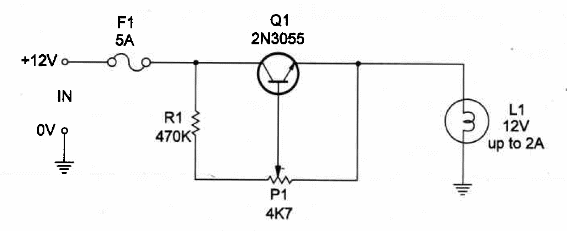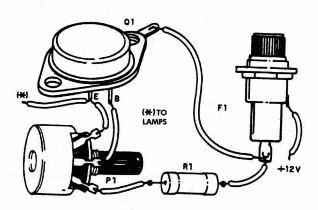This circuit can be used to control the amount of current in an incandescent lamp and also a DC motor.
lf you change the amount of current through a Iamp you change its brightness. And if you change the amount of current through a DC motor you change its speed. Input voltage can range from 6 to 12 volts and current drain in the output is up to 2A.
You can also use this circuit in the output of a 6 V or 12 V fixed power supply, converting it into a variable 0 to 6 volt or 0 to 12 volt supply.
The power transistor should be mounted on' a heatsink. The circuit can be housed in a small plastic box and the heatsink with the transistor fixed on the outside.
The circuit can be used to control brightness of a car's panel Iamps and in robotics to control DC motor speed along a wide range of values.
Also, several experiments involving current flow control can be performed using this circuit.
The circuit acts as a variable resistor or rheostat with the princípal current flowing through the transistor and the control current flowing through the potentiometer.
Current through the potentiometer is only a few milliamperes.
The schematic diagram of the DC dimmer is shown in Figure 1.

Q1 is an NPN power transistor and the principal component used in this project.
Components layout is shown in Figure 2. The transistor does not show on the heatsink, however.

Equivalent transistors can be used, but take care with the maximum current they can control.
Types such as TIP31 and TIP41 can be used to control Iamps up to 2 amperes.
AIso, a further modification in R1 value must be made to ensure that, when P1 is set near its minimum value, that current is flowing through the lamp.
If equivalent transistors are used, take care with their terminal positions, as they can be different.
DC Lamp Dimmer
Q1 - 2N3055 Silicon NPN power transistor
P1 - 4,700 ohm potentiorñeter
R1 - 470 ohm, 2 W,~5°/o resistor
F1 - 5A fuse
Ideas to Explore
To Iearn more about the cichit or to get better performance:
You can use a PNP power transistor, inverting input polarization. Explain why this circuit can only control DC currents.
A Darlington transistor can be used to reduce curreñt flow through the potentiometer. Replace P1 with a 100,000 ohm common potentiometer and R1 with a 10,000 ohm, 1/4 watt resistor when using a Darlington powertransiston TIP1 10 can be used in this case.
What is a rheostat?
Science and uncommon applications:
You can use this circuit to control brightness of microscope Iight sources. A 6V lamp can be used for that task and this circuit wiII be wired between the lamp and a 6 V power-supply. The 6V regulated power supply described in this section is ideal foír this application.
Experiments in electrolysis and electroplating can be current-flow controlled by using this circuit.
This circuit can be used to control small motors in robotics or in physics experiments.
The amount of current in current fields can be controlled by using this circuit and a DC power supply. Experiments involving electrotropism can be attempted. Try to put plants within a coil to observe the influence of the magnetic field on their growth and development. Hemember that there is a magnetic field around a coil of wire that is carrying a current. Figure 3 shows how this experiment can be arranged.

The coil is formed by 10 to 50 turns of common No.18 to 22 wire around cardboard box or wood'form. An ammeter in series with the coil circuit can be used to control the amount of current used in the experiment Remember that too muchtcurrent wiII cause the coil and the transistor to overheat. lt is a good idea to add a Iamp in series with the coil circuit The Iamp will add resistance to the coil circuit, reducing current flow to a safe Ievel.
Note: This circuit is part of the author’s book Fun Projects for the Experimenter Vol1 – TAB Books – 1998




